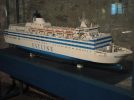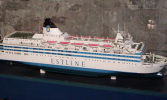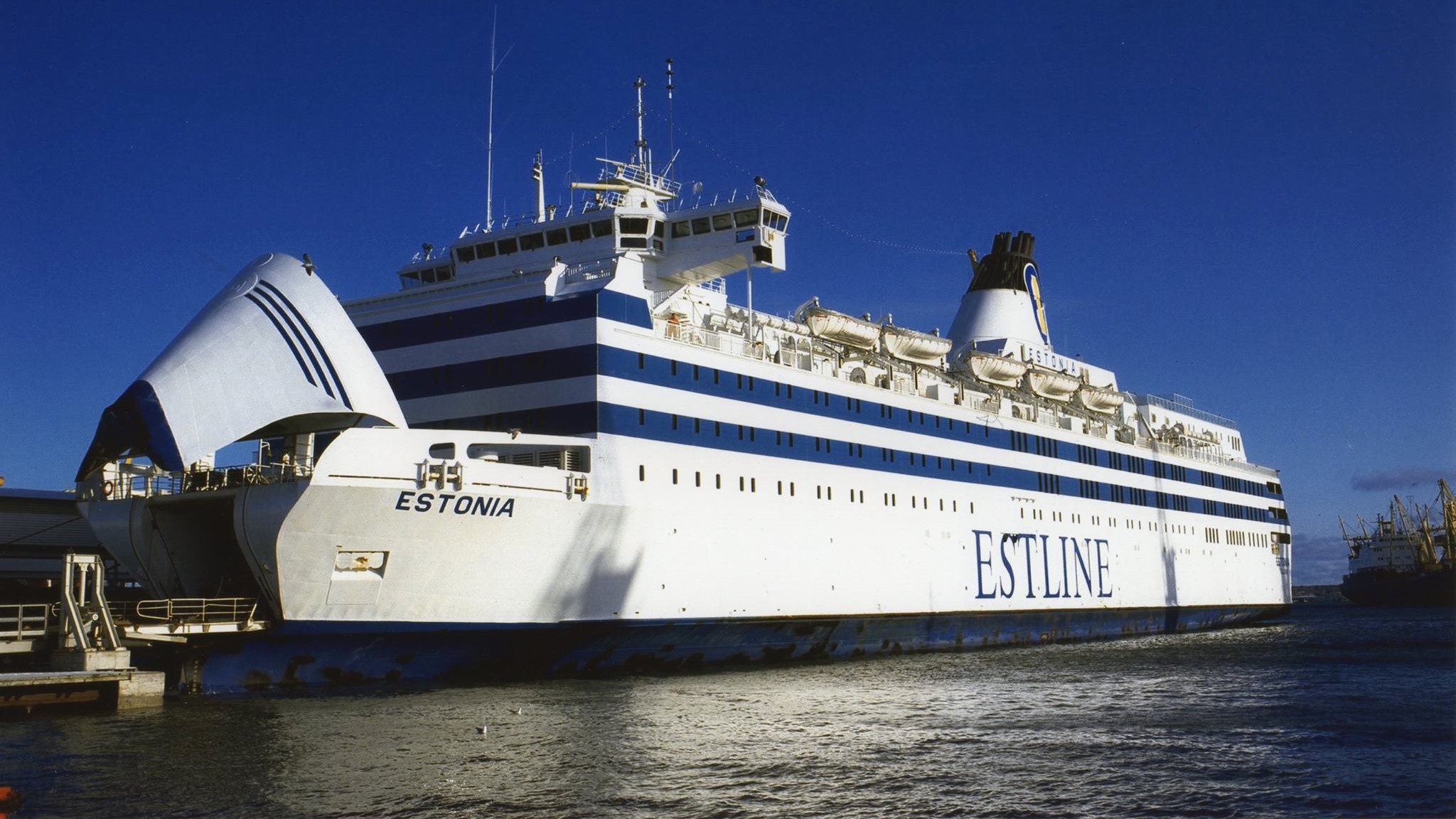Reading this thread, a few things stick out:
- It seems extremely unlikley, at least logically, for a submarine to have hit the Estonia, as doing so would have likely incurred very serious damage to the submarine, if it hadn't sunk.
Yes, I really don't believe this theory at all. It seems very unlikely, and it seems to be very much in the realm of fantasy.
This theory seems to be rather far-fetched. Why would the captain open the bow doors while at sea, when much larger and more practical stern ramps were available. Opening the stern ramps would not subject the vessel to the same structural weaknesses that would be presented by raising the visor. Of course we must consider the practicality of this, especially given, as noted above, that 'military vehicles' delayed the ship and therefore would have been the last to be loaded on. If the ship had been loaded by the bow then the vehicles would have to be unloaded by the bow. Even so, it would have made sense for the ship to be turned away from the wind, to prevent waves from entering the vehicle deck with as much vigour as they would given a headwind (the wind during the sinking was on the port bow). In any case there are a number of logical inconsistencies in this theory of dumping the cargo overboard.
I need to check this, because I might have mixed up bow and stern. I don't remember where I've read this conspiracy theory, but it's likely to have been the stern doors mentioned, not the bow doors. If I've got this right, Estonia would dock stern-first in Tallinn so the ship could sail straight into the Freihman terminal in Stockholm, which means that the two 'late' trucks in Tallinn would have been located next to the stern. It would also be much more realistic at sea for the stern doors to be opened, as you've said.
But either way, it is far too ridiculous and implausible for me. It seems that this whole theory came about as the result of the Master Andresson's whereabouts being unknown, but either way, it sounds decidedly like rubbish. If someone was organised enough to arrange for the ship to be loaded with military hardware, then they wouldn't have had to worry about Swedish customs. As we know, the Swedish customs officers were already previously ordered to ignore certain transports, so why would they be so worried about a couple of trucks?
edit: I was right originally - the bow doors were open in Tallinn, not the stern doors, according to the German Group of Experts. That might also explain the reports that Andresson had real problems berthing in Stockholm, as it would have been required to turn the ship around in the harbour. I've also re-found a video showing cars driving in through the stern doors in Stockholm, so that answers that one. The idea of the visor being lifted at sea and the bow doors opened seems to be ridiculous - with one caveat. Someone, I don't remember who, suggested that the reason why Mariella's log went missing was because it showed Estonia making strange movements at sea. But none of the eyewitnesses reported any strange movements, and I can't believe that it would be possible for the ship to make such a turn at sea without someone noticing.
in case anyone would like to see historical footage of the ship as MS Estonia.
- Lastly, I do remember hearing/seeing somewhere that there had been some correspondance between the Russians and the Swedes, to the tune of "We know you're smuggling our military equimpent on the Estonia, stop it or there'll be consequences." It would follow therefore that the presence of 'secret' military equimpent on board, the suspicious circumstances of her sinking, and the strong reluctance of the Swedish government to permit access to the wreck result in a conspiracy in which deliberate sinking seems rather likely, either from sabotage on-board or from outside, although I have to say that the on-board theory seems to be more likely.
Yes, this is my line of thinking too. I'm very open to plausible disaster scenarios, but there are simply way too many unexplained things going on with this casualty. The one thing that always jumps out at me is this, from the German Group of Experts:
https://www.estoniaferrydisaster.net/estonia final report/21.3.htm - which explains that there was already water on Deck 1 and probably on Deck 0 (below the car deck). This doesn't make any sense unless the ship was already holed, as you'd expect water to come down the stairs from the car deck.
What occurred to me recently is that Russia may not have known exactly what was being smuggled. It may have been enough for them to know that there were orders to let certain transports through the ports in Tallinn and Stockholm without customs clearance, and combined with other intelligence, might have led them to believe that these transports were more significant than they really were. It does seem rather plausible that the smuggling wasn't anywhere near as interesting as we think, especially as it seems quite strange to entrust very valuable military cargo to a civilian ship known to be handled rather poorly.
PS. If we wanted to stick with the 'accidental' sinking view, then we might consider Estonia's time in dry dock shortly before the sinking. Forgive me if this has been covered already in this thread. Between the 10th and 14th of January 1994, Estonia was fitted with folding stabiliser fins at Nantali, Finland. As the ship was not built new with them, they were retrofitted, which necessitated the cutting of openings into the hull, before the prefabricated fin assemblies could be welded to internal brackets and the hull sealed up.
The significance of this is not that the stabiliser compartments may have flooded, as the ship should have been able to retain stability with one or both of them flooded. Rather, it is that, to the best of my knowledge, the stabiliser rooms were situated immediatley forward of the generator rooms and immediatley aft of the heeling tanks. If the stabilisers had been poorly installed, they might have broken loose in the heavy weather and subsequently torn holes across the engine room and the heeling tanks. This would have been exacerbated if there were bilge strakes running across the outside of all three compartments, making it significantly easier to tear one hole across the three.
Further credibility for this theory is that had the three aforementioned compartments been flooded, she would have behaved in a manner more in keeping with the observations of her sinking. As stated previously in this thread, it is very unlikley that the free surface effect would have caused a complete sinking in the time that it did. Considering the effect of flooded compartments below the waterline, her behaiviour during the sinking is much better accounted for.
If anyone could confirm the presence or not of bilge strakes on this part of the hull, I would be very grateful.
From what I understand, it's now confirmed that both stabilisers are present, except that the missing starboard one is deeper than it should be. The Discovery documentary established that, although it's possible that the starboard stabiliser was indeed damaged and inoperable as has been claimed by others. What I don't understand is what it means by the starboard one being deeper than it should be, although does this mean that the damage could have required the use of the pumps to try and get rid of the water from Deck 0?
(source:
https://newsbeezer.com/swedeneng/the-mystery-of-the-stabilizer-of-the-m-s-estonia-is-solved/ )
I think the ship did have stabilisers originally, but that they were replaced for a different kind in Naantali. About the bilge strakes: I'm not sure, but I'll try and find out. Anders Björkman claims they were there, but it's very difficult with him to separate fact from fiction.
However, I think it is a very plausible scenario. It would explain why the starboard stabiliser is not where it should be, it explains the casualty scenario perfectly, and it also reconciles with the testimonies of people on Deck 1 at the time. It leaves open the question of why Sweden is behaving so strangely over the whole affair, but there's always the possibility that they simply don't know why the stabiliser behaved like that. I'm not good enough with naval architecture to comment, but is it possible that an explosion of some sort in the area of the starboard stabiliser (which was known to be in poor condition anyway) could have happened, with the intention of using the stabiliser as a cover story?
It is also noted that, during the investigation of the Erika accident of December 1999, large hull repairs had taken place, the deficient execution of which was blamed for the accident. This somewhat sets a precedent for incorrectly carried-out large-scale hull repairs to cause sinking, so it may not be a surprise if this arose as another theory as to Estonia's loss.
There's also the Jan Heweliusz, which had 30 tons of concrete used to repair a deck fire. That was one of the contributory factors of the casualty, as it turned the ship into a death trap.
Personally, I believe that the presently accepted theory of the bow door coming loose and breaking off has quite a bit of credibility, as the 'visor'-type doors have an inherent design flaw wherein the force of water, especially during heavy seas, pushing against the door will try to force it open. By contrast, the more commonplace 'clamshell'-type doors use the force of water against them to force them closed. It can't however be relied upon by itself to account for the sinking, as the well-documented free surface effect would be expected to produce a different outcome. Therefore I believe it is most likely that the bow-door theory is true, but is being relied upon as the cause to cover up some of the more dubious possible causes.
I think it is perfectly possible that the visor started to break off during the sinking scenario, as eyewitnesses have reported it moving up and down, as well as the fact that the visor was probably full of water at sea. What strikes me as odd about the visor is the way that they were very quick to proclaim that the visor broke off at sea, even though the vessel (allegedly) wasn't found for 3 days after the sinking.
The GGOE on their website also have extensive accounts detailing the visor door on Estonia's poor condition. With bolts holding it shut often being unable to be properly secured. The visor was also apparently 'warped' from the heavy steaming in rough seas that Estonia insisted upon doing. I don't think the Visor door's failure is to be questioned at any rate.
I think it's very fair to say that the visor was badly damaged, the only question is whether it was damaged enough to actually come off in the way that the JAIC claim. Given all the strange behaviour and alleged inability of the Swedish Navy to locate the visor (which is nonsense, we know they were interfering with the wreck quite quickly), it seems as if someone, probably Carl Bildt, had decided to run with the story of the visor being the cause of the casualty. Bildt is known for his strange behaviour internationally, and he'd just lost in elections a few days before.
For me, it's not so much the casualty scenario that interests me as the behaviour of the JAIC and particularly Sweden afterwards. If it had just been an ordinary accident, none of this would have happened.

 bnn-news.com
bnn-news.com





